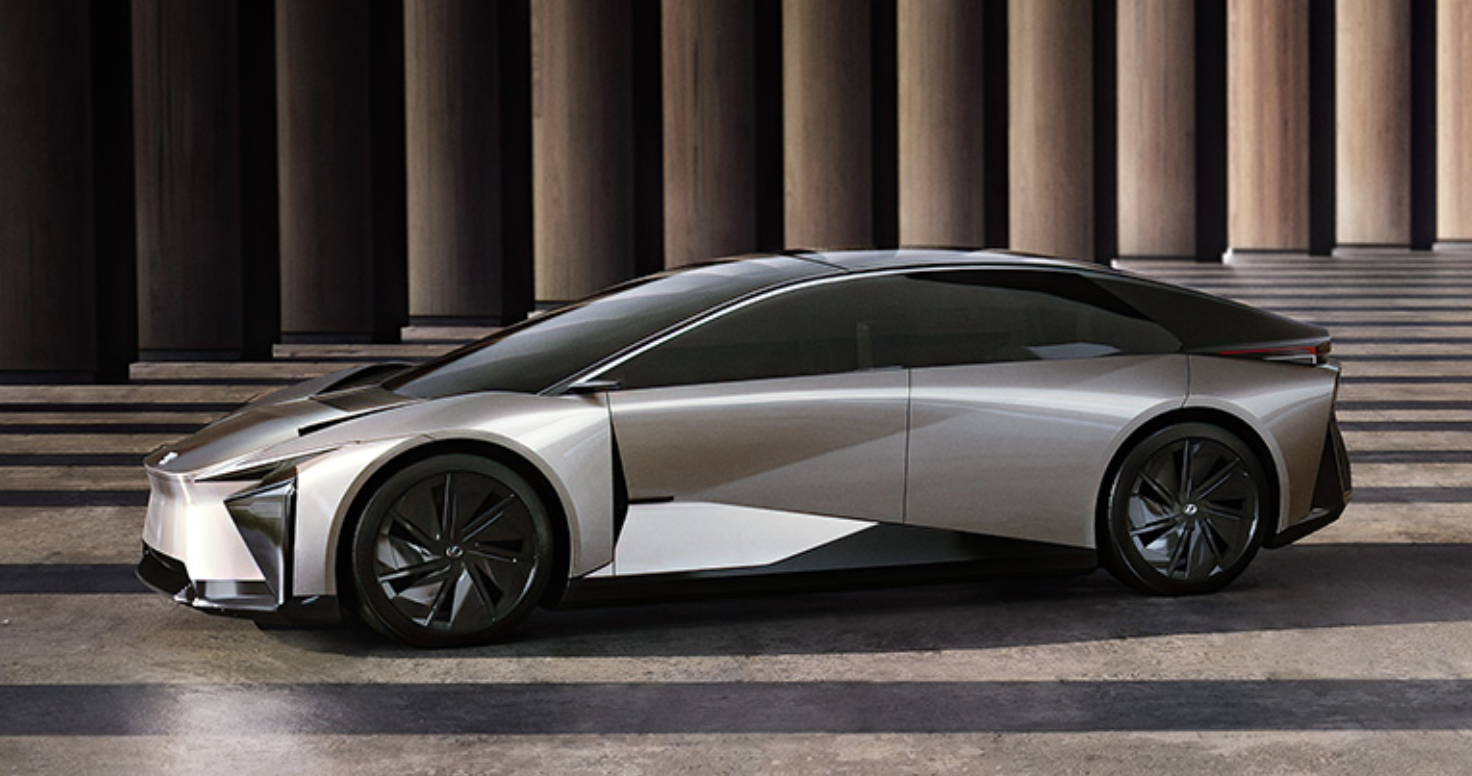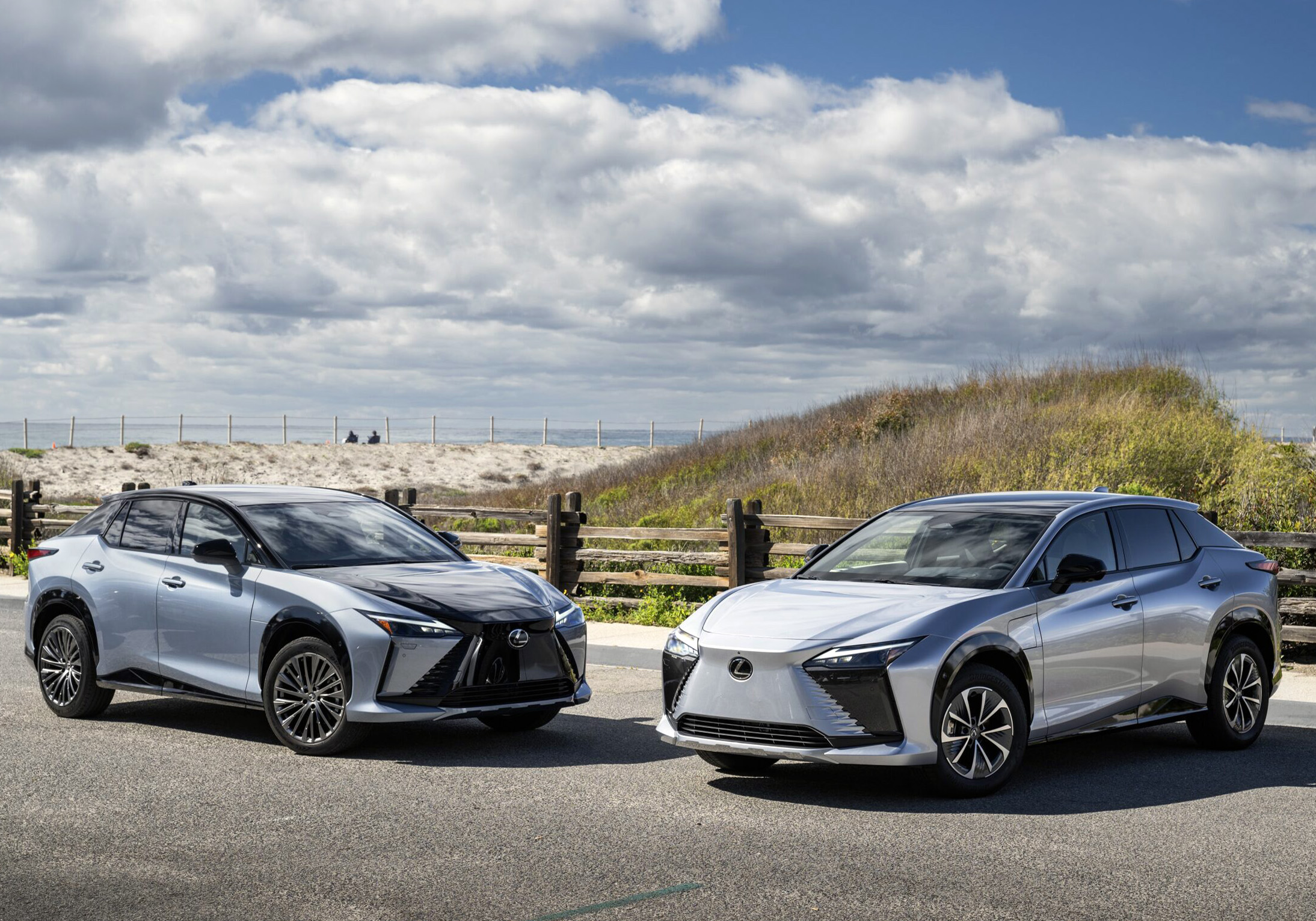
In a move to offer a lower-priced model without lowering posted MSRPs, Lexus has devised a de-contenting option for its all-electric 2024 Lexus RZ crossover. The RZ lineup also swells with a new single-motor version with up to 266 miles of range.
The “Core” option effectively creates a new entry level model by removing a number of non-essential luxury features – such as the panoramic glass roof – from the base trims of the RZ 450e and the newly introduced RZ 300e, lowering their starting prices by $4,200.
The RZ launched in 2023 and while lauded for luxury and comfort was widely criticized for lack of range and relatively high pricing.
All 2023 RZs were designated RZ 450e and came with a dual-motor, all-wheel drive powertrain.
While content, features and design remain unchanged for 2024, Lexus has added a new single-motor, front drive version, the RZ 300e, that has less horsepower but more range than the 450e.
The base version 300e has 201 horsepower and with 18-inch wheels can deliver an estimate 266 miles on a fully charged battery while the 300e trims with 20-inch wheels have estimated range of up to 224 miles. The dual-motor, all-wheel rive 450e with 18-inc wheels delivers up to 220 miles while trims with 20-inch wheels come in at just 196 miles. All 450e trims are rated at 308 horsepower.
To overcome pricing struggles – almost every other small luxury electric crossover starts at a lower price than the RZ 300e, Lexus decided to offer the Core option for those seeking a bargain and willing to give up some features to get it.
With the content-removing option, the starting price of the RZ 300e Premium with 18-inch wheels – including the $1,195 destination fee – falls to $50,950 from $55,150. The 450e Premium with 18-inch wheels would start at $$55,650 with the Core option, down from $59,850. The Core option cannot be applied to Premium trims with 20-inch wheels.
Because it is built in Japan, the RZ doesn’t qualify for a federal clean vehicle tax credit, which hurts in price comparisons with competitors such as the Tesla Model Y Long Range, which is eligible for a $7,500 credit. Cadillac’s Lyriq, another competitor, lost its tax credit eligibility at the start of the year but General Motors is changing its battery supply chain and expects the Lyriq to regain eligibility later in 2024. In the interim, Cadillac is offering its own $7,500 rebate on most 2024 Lyriq models.
With the tax credit, the base Model Y Long Range – available only with all-wheel drive – costs at least $10,000 less than the front-drive RZ 300e Premium and $16,000 less than the AWD 450e Premium. With its manufacturer’s rebate, the 2024 Lyriq with all-wheel drive is about $4,700 less than the smaller RZ450e while the single-motor, rear-drive Lyriq starts about $2,000 below the 300e.
While a tax credit isn’t available to purchasers of the RZ, tax rules make it possible for those who lease any new EV to benefit via a reduced lease rate if the dealer opts to pass on its commercial clean vehicle tax credit.
2024 Lexus RZ Pricing and Features
300e Premium
The front-drive RZ 300e Premium trim with 18-inch wheels and all-season tires starts at $55,150 (including an $1,150 destination fee).
A Premium variant with 20-inch wheels and all-season tires costs $56,390. It is listed separately in Lexus’ catalog because it has less range than the base 300e Premium, thanks to the increased rolling resistance of its larger wheels.
Standard on all versions of the Premium trim are LED headlights, tail lights and daytime running lights; a two-panel panoramic glass roof; imitation leather upholstery; power-adjustable front seats with driver’s seat memory settings; heated and ventilated front seats; a heated steering wheel, dual-zone climate system with rear seat vents and controls; single-color ambient lighting; a 10-speaker audio system; five UCB-C ports, and a Google-based infotainment system with a 14-inch touchscreen.
300e Luxury
The Luxury trim, starting at $60,880, comes with 20-inch alloys and summer tires, Ultrasuede upholstery and door panel trim, acoustic side glass, multicolor ambient lighting, radiant heating for front-row occupants’ lower extremities, heated outer rear seats, a 13-speaker Mark Levinson surround-sound audio system and the Technology package features.
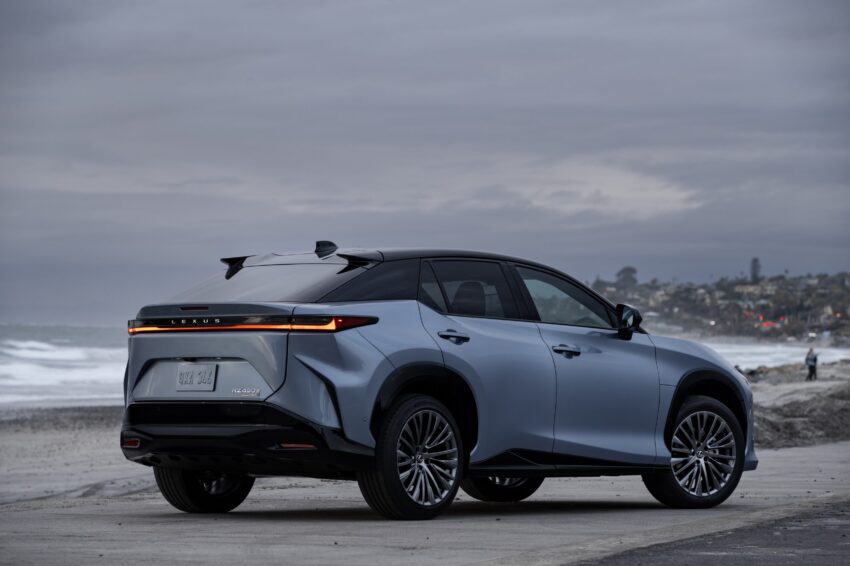
450e Premium
The 450e Premium trim with 18-inch wheels, and all-season tires starts at $59,850 (including an $1,150 destination fee). The variant with 20-inch wheels and all-season tires costs $61,090. Other than powertrain, the 450e Premium is equipped identically to the 300e Premium.
450e Luxury
The top-of-line 450e trim starts at $65,580 and has the same standard features – except powertrain – as the 300e Luxury.
Those Options
In an unusual move to provide a lower price to bargain hunters, Lexus is offering a new-for-2024 Core option package for the base RZ Premium trims with 18” wheels that removes content and lowers the MSRP by $4,200. Oping for the package removes the panoramic view monitor, backup camera washer, power tailgate with kick sensor, ventilated seats, panoramic glass roof, ambient lighting, the intuitive parking assist with auto braking system, and the seat, mirror and side mirror memory system.
With the Core option, the starting price for the RZ 300e Premium with 18-inch wheels drops to $50,950 while the 450e Premium with 18-inch wheels would start at $55,650.
Options that add items – and cost – to the Premium trims include radiant heating for front seat occupants, $175, and a $1,655 Technology package that adds a head-up display, digital key and the Lexus Advanced Park system for automated parallel and perpendicular parking.
Options for both Premium and Luxury trim levels include a lighted front badge, digital rearview mirror and a cold weather package that includes headlight washers and a windshield deicer. Each option is priced at $200.
A $550 electro-chromatic dimming system for the glass roof is the only option exclusively for the Luxury trims.
Safety
The 2024 Lexus RZ hasn’t been crash-tested by the National Highway Traffic Safety Administration, but the Insurance Institute for Highway Safety rated it a Top Safety Pick + in late 2023 after it aced the non-profit organization’s battery of crash tests and safety equipment evaluations. The rating carries over for2024 models.
Both RZ trims get the Lexus Safety System+ 3.0 suite of driver-assist and safety tech as standard equipment. It includes full-range adaptive cruise control with curve speed management, forward-collision warning and mitigation with pedestrian and daytime cyclist detection, lane-departure warning, lane-keeping and lane-centering assist, intersection turn assistance with oncoming traffic and pedestrian detection, and evasive steering assist. The RZs also get blind-spot and rear cross-traffic monitoring, and parking assist with rear pedestrian detection. The Luxury trim adds front cross-traffic alert, lane-change assist, and, with a free three-year trial, traffic jam assist.
Power and Performance
The 2024 Lexus RZ is available in two electric powertrain choices. The 300e trims get a single, 201-horsepower motor driving the front wheels. The 450e trims are equipped with a dual-motor electronic all-wheel-drive system rated at 308 horsepower and 321 pound-feet of torque. The RZ uses a single-speed gearbox and there are four preset drive modes — Eco, Normal, Sport, and Range (for maximum distance) — plus a fifth that can be customized.
The 450e’s computer-controlled all-wheel-drive system is biased toward rear-wheel drive when cruising. When increased traction is needed, the system can send power to either or both axles and can apportion torque among all four wheels.
We haven’t driven the new RZ 300e with front-drive, but the RZ 450e delivers a Lexus-like ride — stable, comfortable, and remarkably quiet — with a sporty level of responsiveness. The RZ share its platform with the Toyota bZ4X and Subaru Solterra, but has its own suspension tuning and substantially improved handling. There’s very little body roll on curves and corners, and most potholes and other road irregularities are swallowed up before they are felt in the cabin.
Lexus added a subframe at the rear of the RZ 300e – where the rear motor fits in the 450e – and tuned the suspension to compensate for the difference in weight; the 450e versions are, on average, 220 pounds heavier than the 300e.
Steering is quick and responsive. An optional steer-by-wire system with an aircraft-style yoke instead of a steering wheel, initially shown as a prototype in 2023 with a 2024 production date, was still undergoing fine-tuning by Lexus engineers as the new year began and may not make it onto the 2024 model. The system takes a little practice to master, but is even quicker than the RZ’s electrically assisted mechanical system.
Braking is linear, and there are four levels of regenerative braking set by clicking paddle shifters mounted on the steering wheel. The regeneration ranges from none to a whole lot but won’t bring the RZ to a complete stop, as does so-called one-pedal regeneration.
The RZ is the longest crossover in its competitive set, but it’s still almost 3.5 inches shorter than the midsize Lexus RX. It is easy to wheel through traffic and a breeze to park with the automated parking system that’s standard on the Luxury trim and part of an optional package for the Premium.
While not a racer, the RZ is fairly powerful with a 0-60-mph sprint time of 5 seconds flat for the dual-motor versions. That’s not quite as fast as the Tesla Model Y or [Volvo C40 Recharge, but beats the rest of the likely competition.
Range and Charging Time
By dropping the RZ 450e’s complex and hefty electronic all-wheel drive system, the new RZ 300e variants gain a considerable weight advantage that translates to more range: An estimated 266 miles for the Premium trim with 18” wheels and 224 miles for the Premium and Luxury trims with 20” wheels.
Unfoetunately for Lexus, competing small luxury electric crossovers with single-motor powertrains all do better.
All-wheel drive RZ 450e trims also trail their counterparts, at 220 miles of range for the Premium with 18’ wheels and 196 miles for the variants with 20” wheels.
The subcompact 2024 Volvo C40 Recharge] posts an impressive 297 miles of estimated range in rear-drive configuration and 257 miles with all-wheel drive. The 2024 Genesis GV60 Advance, at up to 294 miles in rear-drive and 248 miles with AWD, the Audi Q4 e-tron at 265 miles with rear drive and 236 miles with all-wheel drive, and the 2024 Mercedes-Benz EQB 300, at 250 miles with rear-drive and 243 miles with all-wheel-drive, occupy the middle ground. The Tesla Model Y Long Range is te segment’s range king at 330 miles.
The midsize 2024 Cadillac Lyriq crossover, while in a bigger size category than the RZ, is in the same price range, costs even less after incentives are applied, and delivers up to 314 miles with rear-drive and 307 miles with all-wheel drive.
The RZ uses a 6.6 kW onboard charger for overnight home charging on a Level 2 (240-volt) system in about nine hours. That’s a slower charger than the 11 kW most competitors offer, but charging time is par for a segment in which home charging times range from 7 to 11 hours, depending on battery capacity.
For road trips, the RZ has a CCS charging port and can access DC fast-charge stations (except Tesla Superchargers) at speeds of up to 150 kW. That’s enough to bring a battery from 20% to 80% of capacity in about 30 minutes. A few Tesla Superchargers have been equipped with a so-called Magic Dock that enables use by non-Tesla EVs and more adapters reportedly are coming as Tesla opens its once-proprietary system of fast chargers to the rest of the EV world. Lexus, like almost all major automakers, has said that its EVs will come equipped with Tesla’s NCAS charging systems starting in 2025.
The RZ’s quick-charge times are average in its segment. The outliers are the Model Y and GV60, which can do DC fast-charging at much higher speeds. The Genesis leads the pack with an 18-minute top-up time — from 10% of capacity to 80% — on a 350-kW fast charger.
Inside the RZ
The 2024 Lexus RZ is every bit the modern EV, with a clean, minimalist look. It has a quality interior with soft-touch surfaces, ambient lighting, nicely padded and supportive seats, and a 14-inch digital touchscreen dominating the dash.
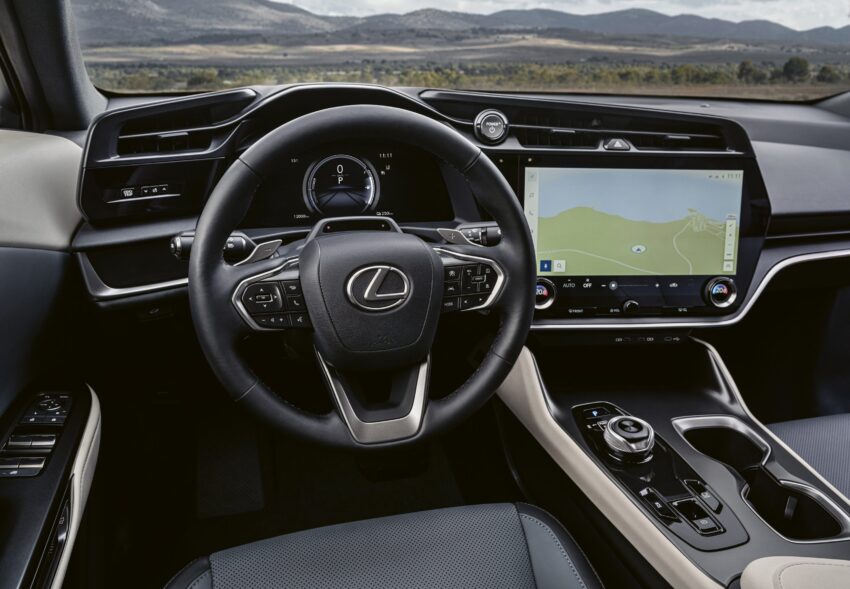
The driver gets a large configurable digital information panel. All instrumentation and screens are oriented toward the driver for easy visibility.
The front passenger gets considerable extra knee- and legroom because designers omitted the glovebox. In its place is an upholstered surface that houses the wiring for a radiant heating system that works with the seat heaters to warm front-row occupants’ lower extremities while reducing the main heating system’s drain on the battery.
The cabin is roomy and very quiet. Even in the Premium trim, without the Luxury trim’s acoustic side glass, the 2023 RZ admits very little road or wind noise.
There’s a minimum of bright-work and vents. A lacy light pattern is projected on the upper door panels, adding visual interest in low-light conditions, and both trims come with a panoramic glass roof with great UV protection and no need for an interior shade screen.
The RZ’s 42.1 inches of front legroom is nearly identical to the spacious Genesis GV80 – a much larger vehicle. Its 37.5 inches of rear legroom trails the Tesla Model Y, Mercedes-Benz EQB](and, by a scant tenth of an inch, the Genesis GV60. But it is still plenty for all but the tallest passengers. Headroom is plentiful in both rows, with the second row leading the class at 39.7 inches. The RZ’s 39.8 inches of front headroom is slightly less than offered in the Model Y.
Behind the 60/40 split rear seats, the RZ offers 23.7 cubic feet of cargo space. That’s enough for 10 bags of groceries or two suitcases. With the seat backs folded down, capacity expands to 55.6 cubic feet. That’s less space behind the rear seats than the Model Y (30 cubic feet), Cadillac Lyriq (28 cubes), Audi Q4 e-tron (24.8 cubic feet) or GV60 (24.7). In total cargo capacity, the RZ trails the Model Y’s 76.2 cubic feet, the Lyriq’s 60.8, and the EQB’s 57 cubes.
While there’s no glovebox or underhood “frunk,” the RZ has hidden storage beneath the cargo bay floor. There’s also plenty of space for small items in the console’s bin and cubby, the door pockets, and the expanding hard-backed pockets on the backs of the front seats.
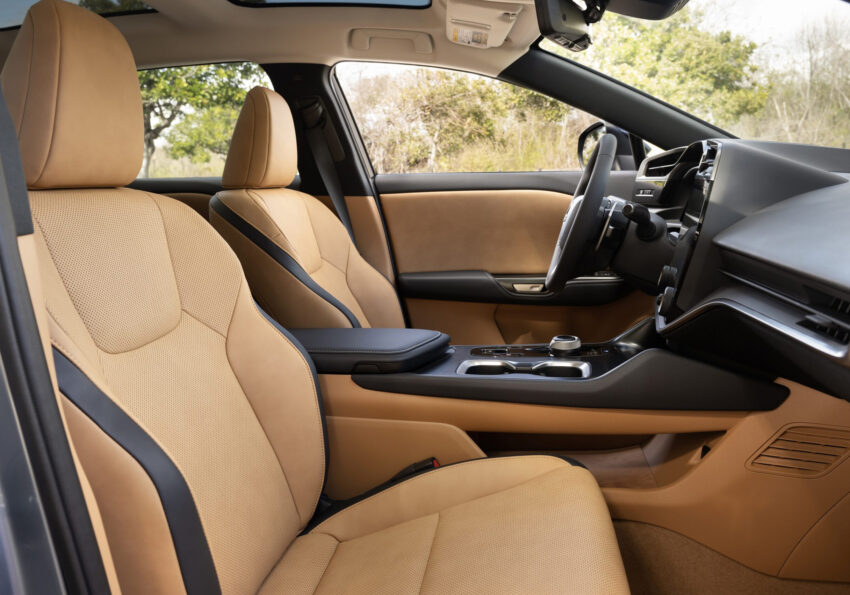
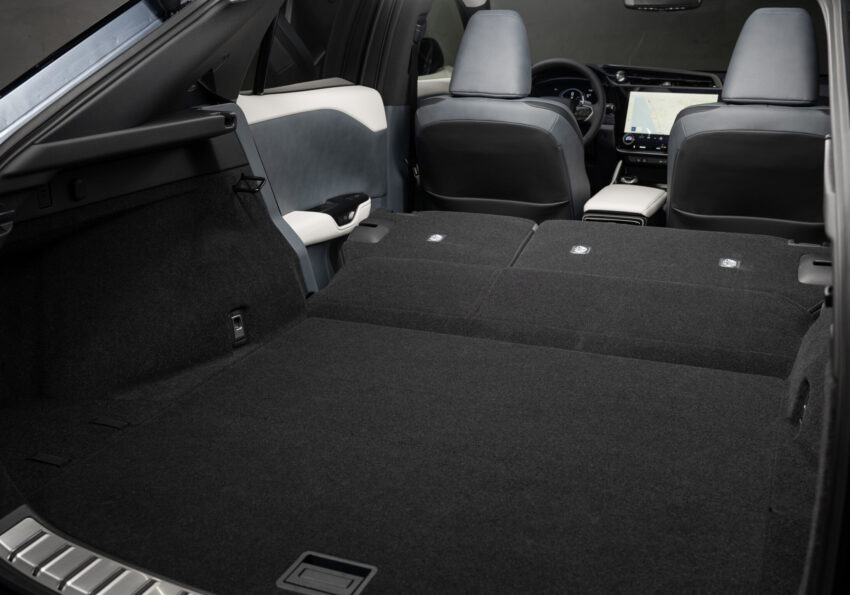
Infotainment and Connectivity
Lexus has equipped the 2024 RZ with a 14-inch touchscreen running the Google-based Lexus Interface operating system. It works great with voice control. Icons are smartly arranged and easy to see and use, although there are too many functions buried into the system. Often-used features such as the drive modes can take several button touches to access. The RZ’s interior designers did tilt the big screen toward the driver for easy accessibility.
There are physical knobs below the screen for the climate control system and audio volume, but channel changing and temperature setting has to be done on the touchscreen.
Wireless Apple CarPlay and Android Auto are standard, along with Alexa connectivity. An in-car Wi-Fi hotspot is available via subscription. There are five USB-C ports, three in front and two for the second-row passengers, as well as a wireless charging pad. Cloud-based navigation is available via subscription, but comes with a three-year free trial period.
The Premium model gets a 10-speaker Lexus audio system, while the Luxury goes all out with a premium 13-speaker Mark Levinson surround-sound system.
Is it Enough?
The 2024 RZ is a nicely done small electric crossover with two major weaknesses – it doesn’t go as far as and, at the entry level trims at least, costs far more than most likely competitors.
RZ 450e sales in 2023 weren’t exactly awe-inspiring and Lexus apparently is hoping that the new, less powerful but longer-range 300e version, combined with the unusual Core option that removes content and lower the starting price of the base trims in each variant will help move more metal.
Ir would have been better had Lexus parent, Toyota, designed and engineered its first full EVs (the Toyota bZ4X is the RZ’s platform-mate) to be truly competitive in price and range from the get-go. But Lexus’ moves with the 2024 RZ might help until the company’s next attempt in 2026 with the production version of the LF-ZC electric sedan concept (below) unveiled last year.
